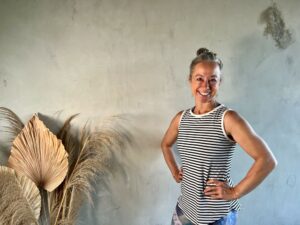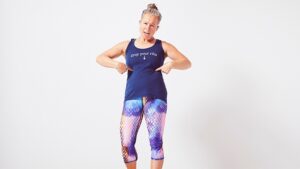It’s true – going furniture-free is a thing! Getting rid of regular chairs, tables, sofas and beds is one of the easiest ways to add more movement to your life. You get instant movement variety and you build in lots of strength and flexibility opportunities. It’s a serious game-changer when it comes to maintaining your whole-body health and wellness.
But, let’s face it, it also seems a bit weird at first. I can speak from personal experience – your partner might not want to get rid of the sofa! And what happens when you have guests? And what would it all LOOK like?
Well, my friends, I decided to tackle this one head on. I’ve asked some of my very favourite movement people to share photos of their homes! I asked them to show how they’ve created movement friendly living spaces that work for their lives.
I already live with minimal furniture, and I was blown away by how these amazing women have integrated movement into their lives and their style.
Full disclosure: I’m hoping that seeing these spaces inspires YOU to invite more movement into YOUR life by rethinking some of your living spaces. Let’s check them out!
Galina Denzel
I met Galina at my very first training week with Katy Bowman. She’s one of the best (and healthiest) cooks I’ve ever met, and you could never turn around without catching her doing some sort of crazy exercise like standing on one leg. She’s a seriously incredible health coach and wrote one of my fave books too – Eat Well, Move Well, Live Well: 52 ways to feel better in a week. It’s a great book, packed with simple and practical healthy ideas, and Galina truly walks her talk.
Galina and her husband Roland Denzel are both health authors and health coaches. They live in a two story condo in Southern California. Galina is a Nutritious Movement Restorative Exercise Teacher and Somatic Experiencing Practitioner who specializes in working with people with chronic pain, fibromyalgia and chronic fatigue. She blends nervous system regulation and restoring whole body and natural movement to facilitate the healing that wants to happen for all of us.
Galina can be found at eatmovelive52.com
Why did you pick these spaces to share?
These are the spaces that I most often find myself in at home. I love the floor and the stairs as I can move my body the most, while still being able to focus.
While I enjoy standing up I do that at my stand up station at work and I stand there all day long, so when I work from home, study, or do creative work, I love to sit on the floor and stairs. It allows me to be centered, while also lets me put my body in positions I don’t get to at work with my students. The stacking tables and Indonesian desk are my favorite surfaces and the “stairs couch” is our morning hang out place to stretch, read and sip on coffee. My step kids also love to sit on the stairs while we cook.

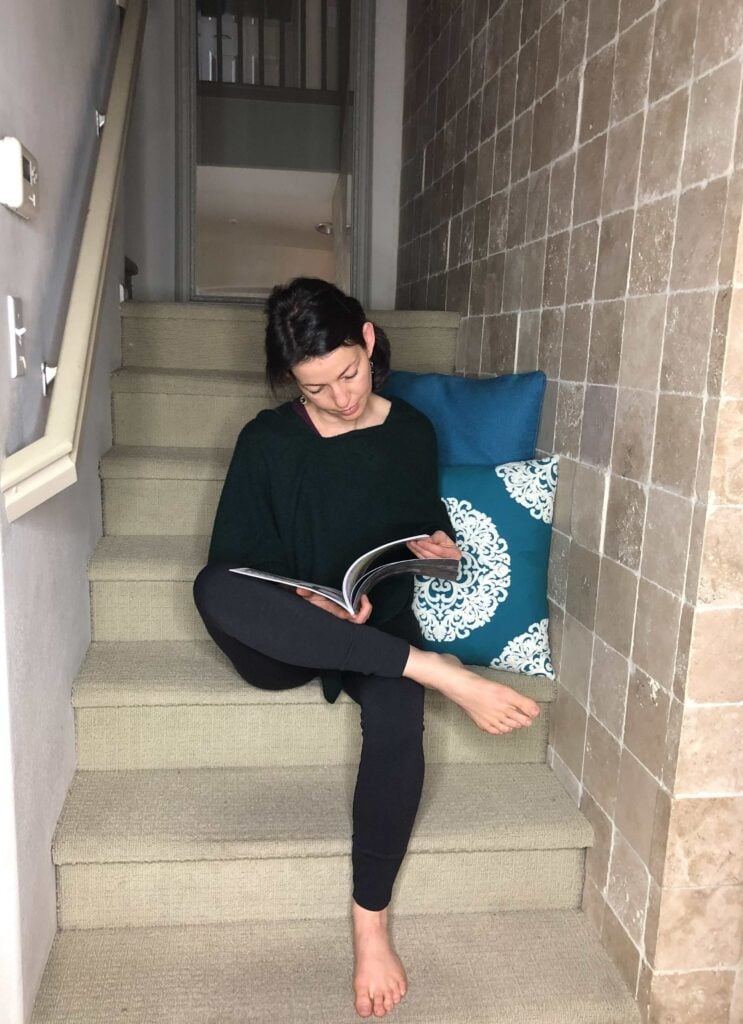
What was hardest about transitioning to less furniture for you?
You know, the hardest thing was that I love snuggling on a couch with Roland. And there is something about organizing the home around a couch and coffee table that I am used to just culturally. We don’t entertain a ton and when we do our guests naturally gravitate towards the kitchen table that has chairs and benches. Being able to invite them on cushions on the floor has worked for some, but not for others.
What do you love most about using less furniture?
We are about three years into this home transition and we both find that it’s easier to get up and down.
My body feels more fluid and more able to get in and out of positions. This ease of movement is just delicious and pleasurable to experience somatically.
I also have tons of space to roll on balls and do other soft tissue work while watching TV (the TV is not pictured here, but it’s up on the wall). There is a certain level of freedom to just be able to plop on and off the floor any time and anywhere.
I also love that it’s easy to clean, there are many ways to arrange the furniture and it looks neat and open. I am a bit of a minimalist when it comes to stuff. I don’t like having many things anyways and we move often, so it’s truly been a blessing for our lifestyle.
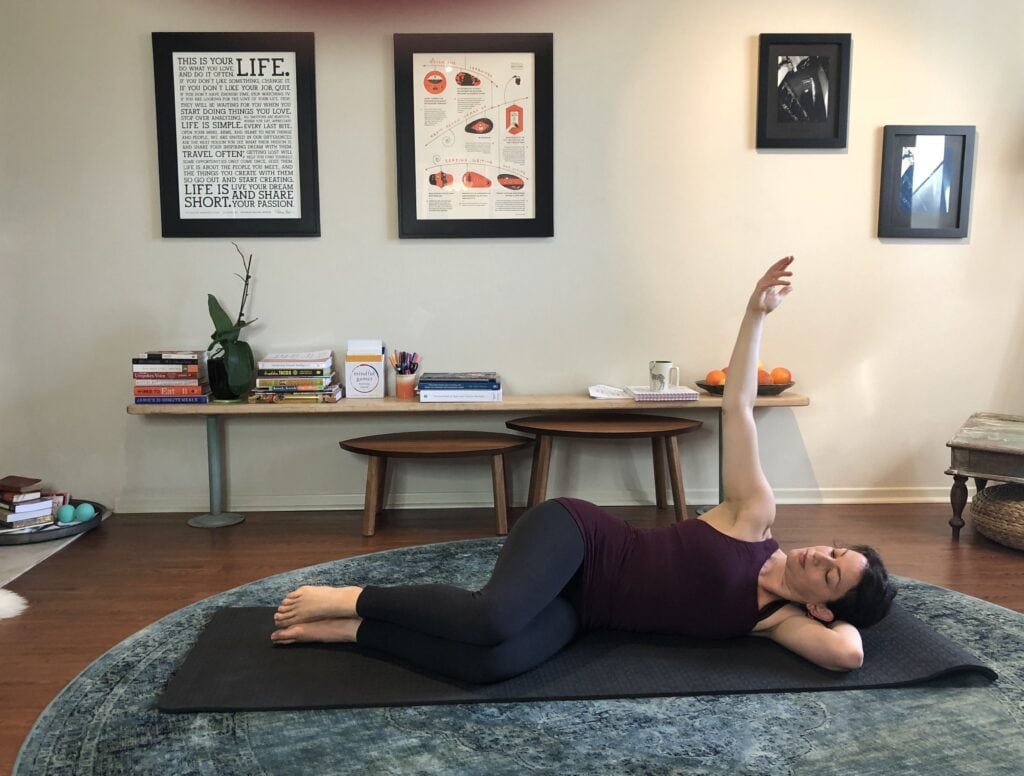
What’s your favourite furniture-free space?
My round wool carpet. I love to sit on it, do my movement practice on it, dance on it. We often just clear everything off of it and we dance together
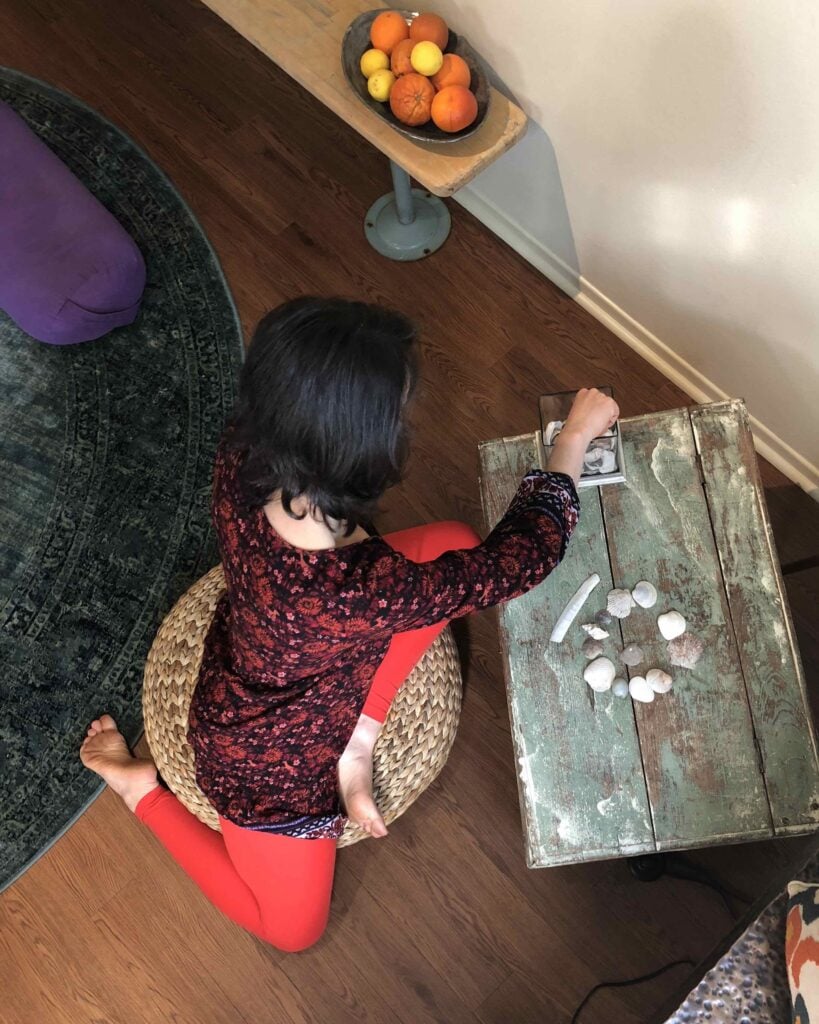
Do you have any tips for people who want to create more movement-friendly spaces in their own homes?
#1 Be brave and get rid of the big bulky things. If you cannot physically move it easily yourself, then maybe it should not be there.
#2 Pay attention to how you like to move and what kind of space you need at home and create it. Don’t squeeze yourself in a corner between a bed and a dresser – this is no way to create a movement practice.
#3 Your space should be dance friendly, whether you dance or not – dancing is a good way to check a space for freedom and air. Have all of your toys close by (rollers, bolsters, balls, straps, bands, ropes).
#4 Do not be afraid to spend several hundred dollars on pillows and blankets to make your space pretty and cozy, so it’s the colours and shapes you like. It’s always going to be cheaper than buying couches and furniture, and it’s easier to clean.
How does your partner/family/guests feel about living with less furniture?
We wrote a whole chapter in our book Eat Well Move Well Live Well, called “furniture minimalism”, where Roland shares his feelings. He has welcomed it, but we are also very flexible about it, for example we have a regular bed with a firm mattress. My step kids think it’s a bit weird, and joke that even our bench by the window, which kind of looks like a couch is made of copper to discourage one from getting too comfortable for too long. Many of our guests who love to move are happy to roll around and sit and stretch on the floor. Others stick to the kitchen area and chuckle about it. Pretty much everyone finds it quirky, but not so quirky that they won’t play along.
Carol Robbins
My friend Carol actually lives in Toronto but in the Beaches area – which is so far from me that we see each other more often at out-of-town trainings than in our own city! Carol is basically brilliant at whatever she does, and has two of the most lovely and hilarious cats ever, who often join her for movement time.
Carol not only lives in her home but also teaches out of it, so she’s a true example of how you can make your space extremely versatile when you have less furniture. She’s a Restorative Exercise Specialist since 2013, and has been teaching movement since 2000, so she brings incredible depth and perspective to her work and life. As well as her cats, she shares her home with a tolerant husband who has agreed that she can store all his heirlooms in the basement.
You can find Carol at: http://www.alignmentrescue.com/
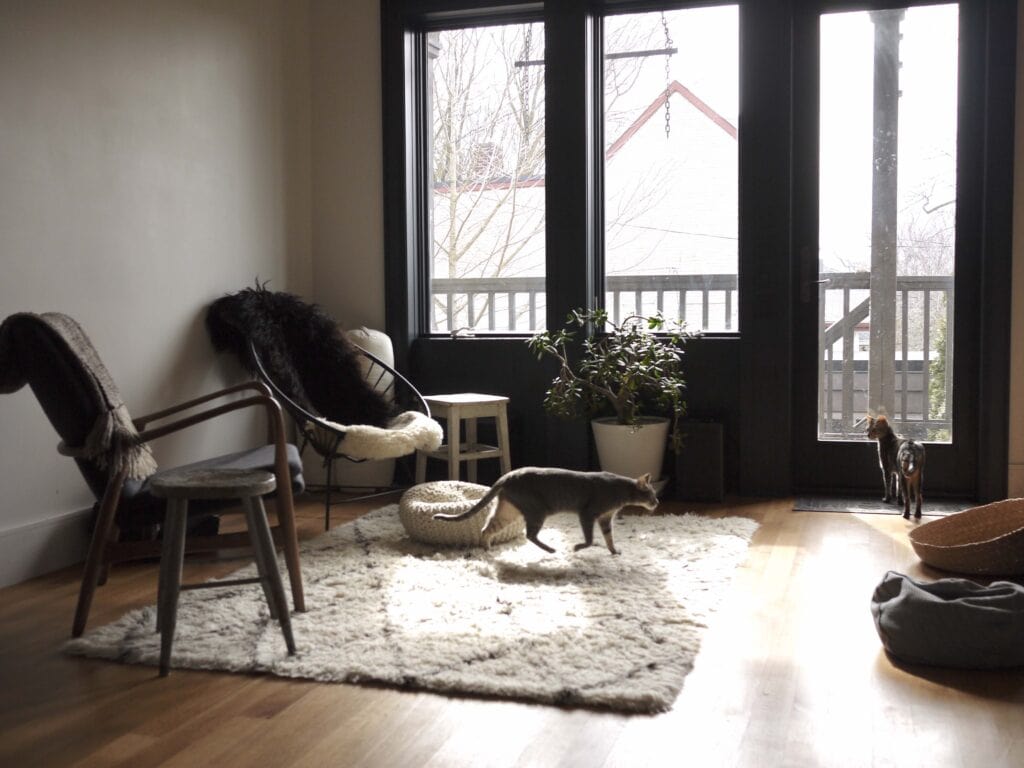
Why did you choose this space to share?
I chose this area because it is my living room. I’ve been thinking about the meaning of that description, and how in my suburban youth, the living room was an area where almost no living was done, only on very special occasions. Otherwise, you were in the family room.
I think the whole house should be for living, and I’m fascinated by minimalism and Japanese aesthetic, where rooms and pieces have multi-functions.
I find myself needing less and less by using the same spaces for more and more.
This necessitates movement continually to re-arrange things to serve different purposes. For example, the side tables are stools that I use for class. There are several poufs and buckwheat zafu that I sit on that are also class props. (The cats prefer the chairs.) The light swings away so that I can use the wall for exercises, and there is no artwork for that reason. I am planning on painting a mural on that wall soon.
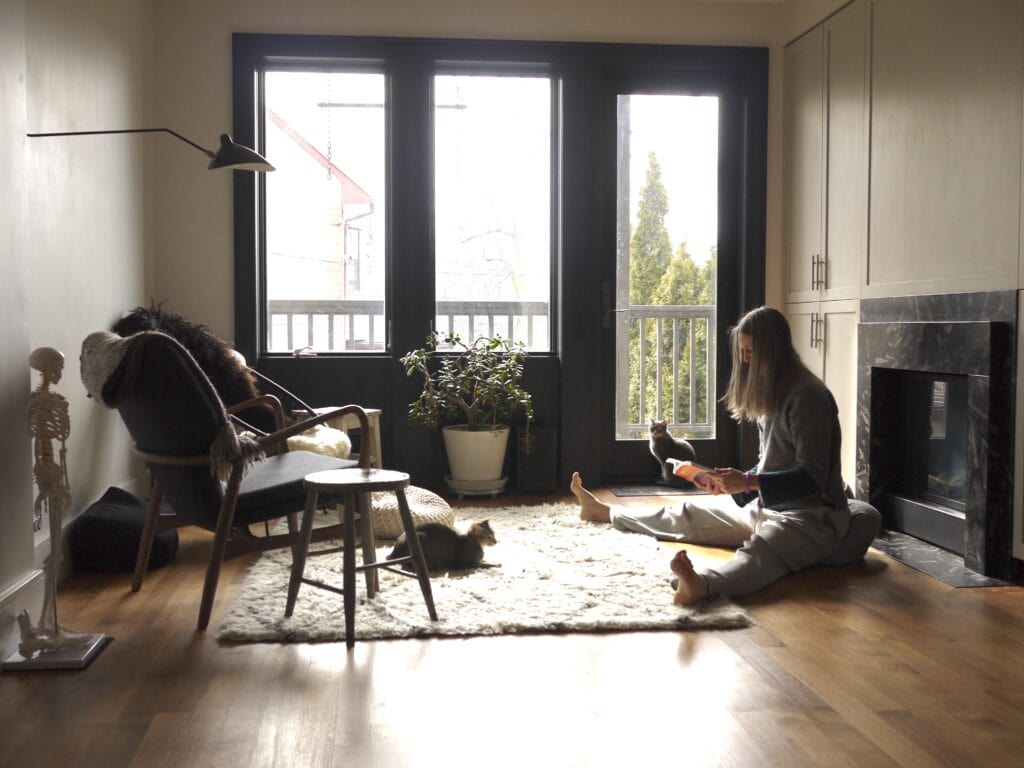
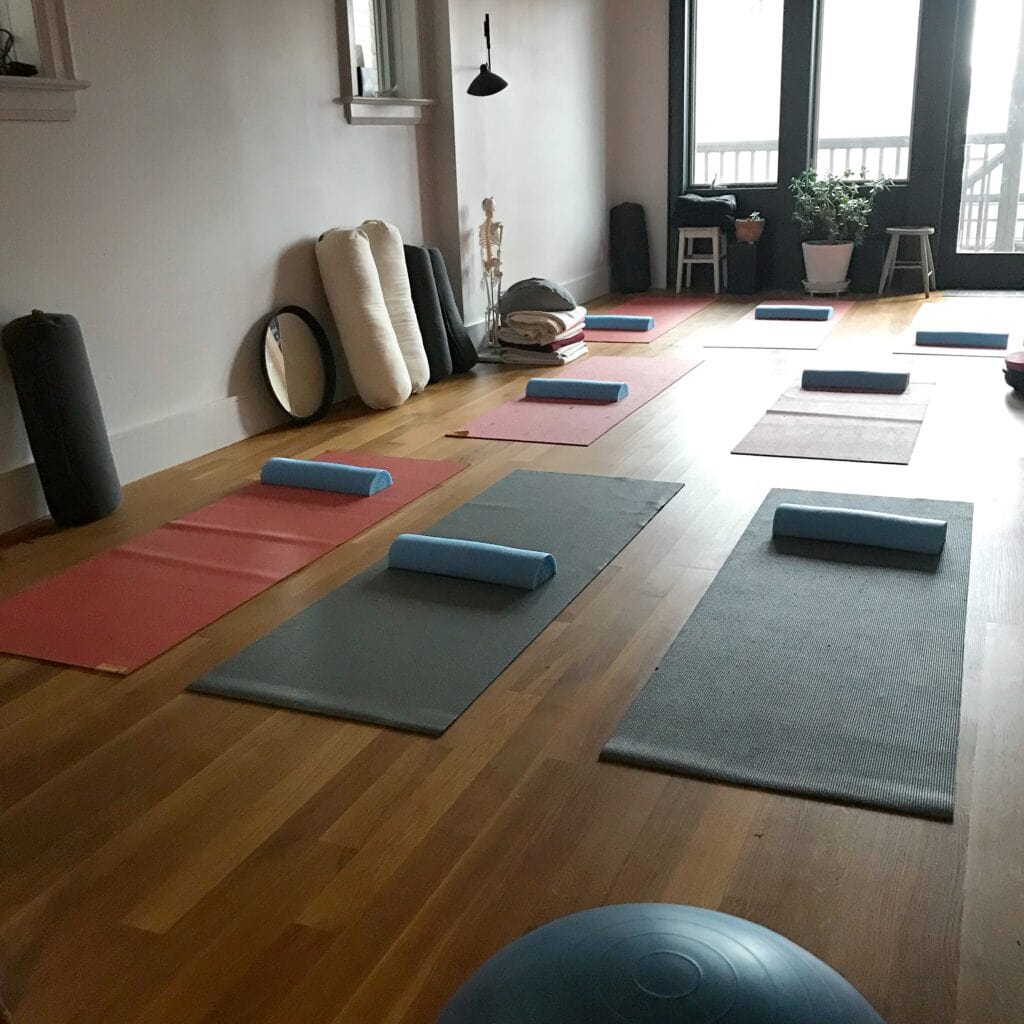
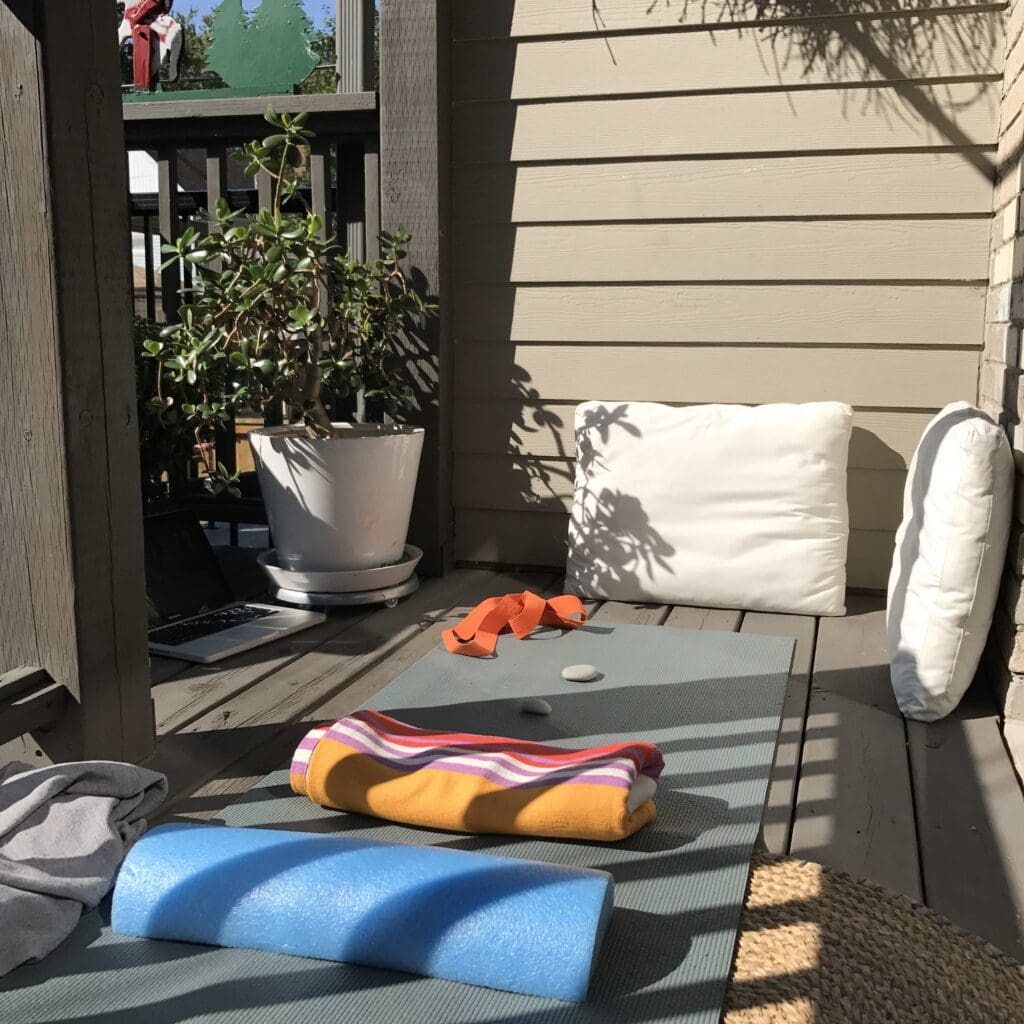
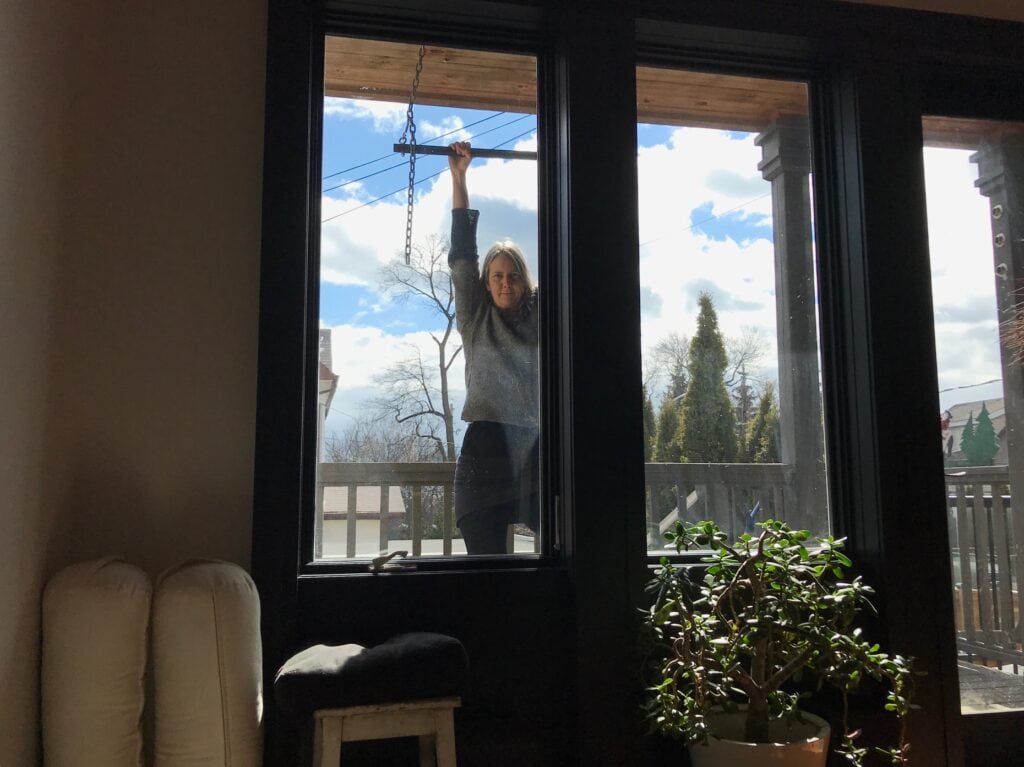
We have a permanent floor to ceiling mirror in the space, which is great for teaching but was also an architectural element to fill a dead and dark space between the basement door and the cupboards. It is like an opening to another room, and is an optical illusion.
I keep my work equipment and reference books in the cupboards beside the fireplace.
My clients like the gas fireplace on those chilly winter mornings. The window ledges are wide enough and at a perfect height to place a laptop for standing desk opportunities, as is the railing outside on the porch, which I call my “summer office.”
We still have a lot of stuff in storage that needs to go. It takes up all the room in the basement and the garage, so we have these airy open spaces that make me feel very happy and clear-headed, and then a few steps away there is chaos! Eventually it will all find another home I hope.
The bedroom is my Japanese room, where I sleep. My husband still prefers his more traditional space, so we sleep separately. At this stage in our lives, we enjoy being able to keep our own hours and habits. The cats sleep with me. The rice tatami mats are beautiful and authentic, as is the futon, from Japan. I have another bedroom with a bed that is kind of in between a floor bed and a traditional bed – it’s on a low platform. So there are many ways to transition!
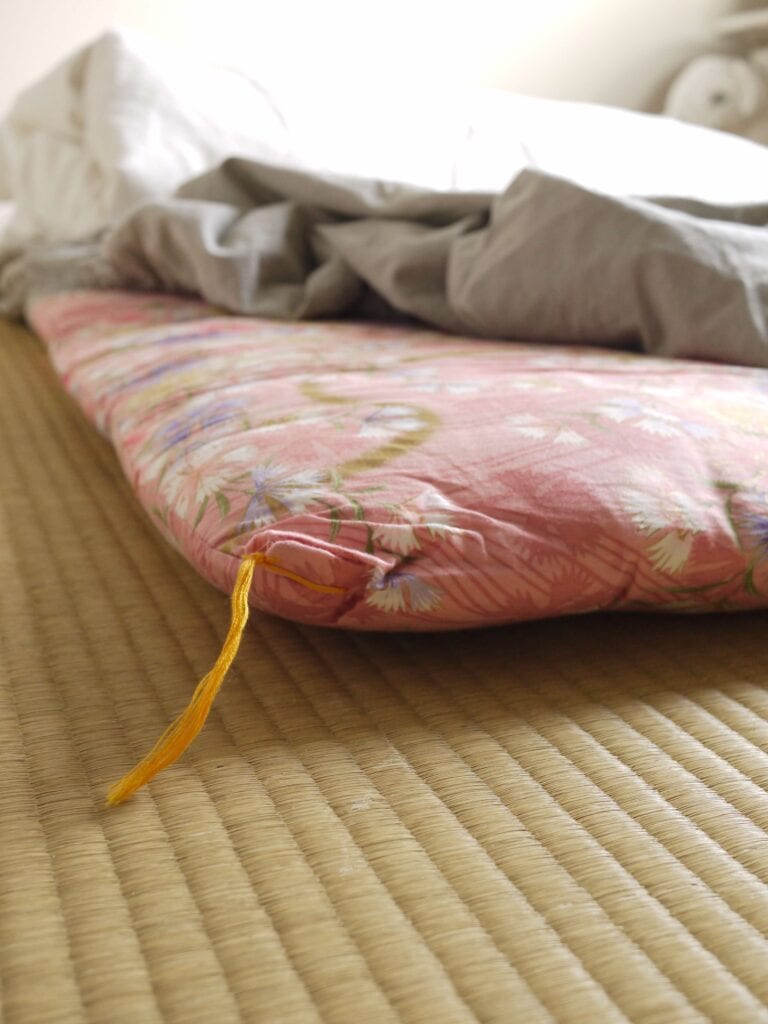
Where do you go to find awesome movement-friendly furnishings?
Tatami mats and futon from East West Futons
Zafu and poufs from http://www.healthylifecycle.ca/
Acapulco chair from the Bay
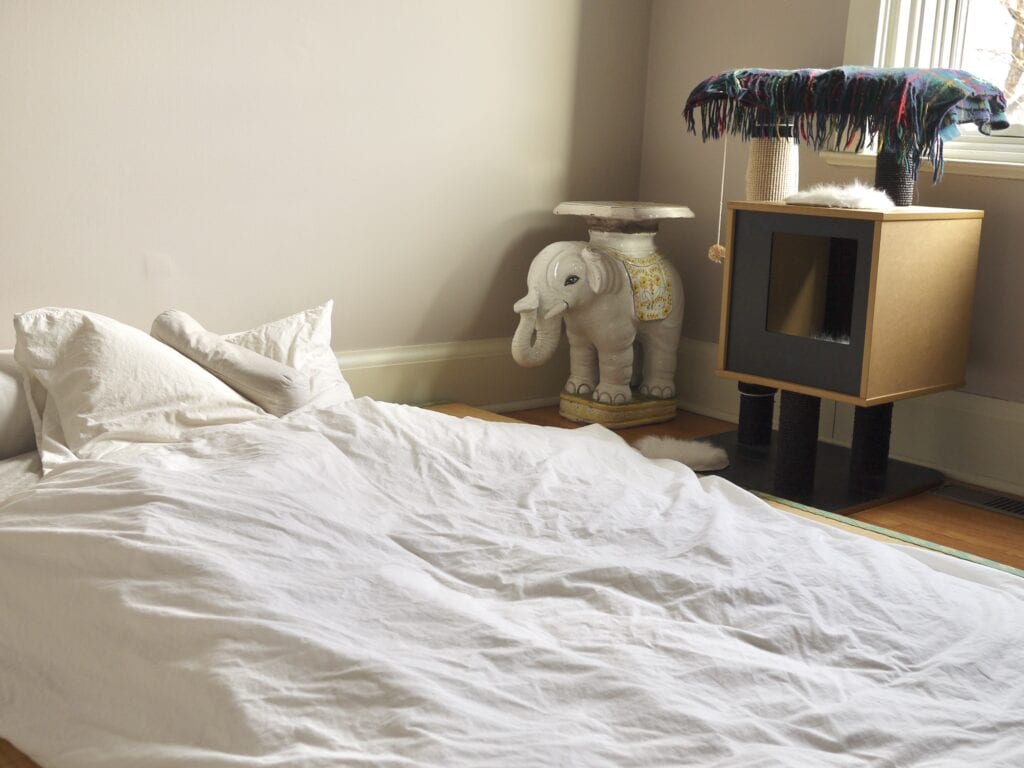
Jennifer Gleeson Blue
I met Jennifer in 2014 at my first Restorative Exercise training, and I’ve been a huge admirer of hers since then. She has an amazing soul and deep insight into helping her students nurture positive change in their bodies and their lives. She’s just starting to settle in a new home with her husband and son after a long year of travel and transition (they moved from Philly to Santa Fe with a lot of stops and soul-searching in between), so she’s in the middle of actively figuring out how to integrate movement into her new home space.
Jennifer is a heart-centered movement teacher and Restorative Exercise Specialist. She equips women who are on a journey to stop battling against themselves — their physical and emotional pain, their limitations, their family and even the culture at large — by transforming their fight, embracing their vulnerability and moving into their truth and wholeness.
Jennifer can be found at www.theresilientbody.com
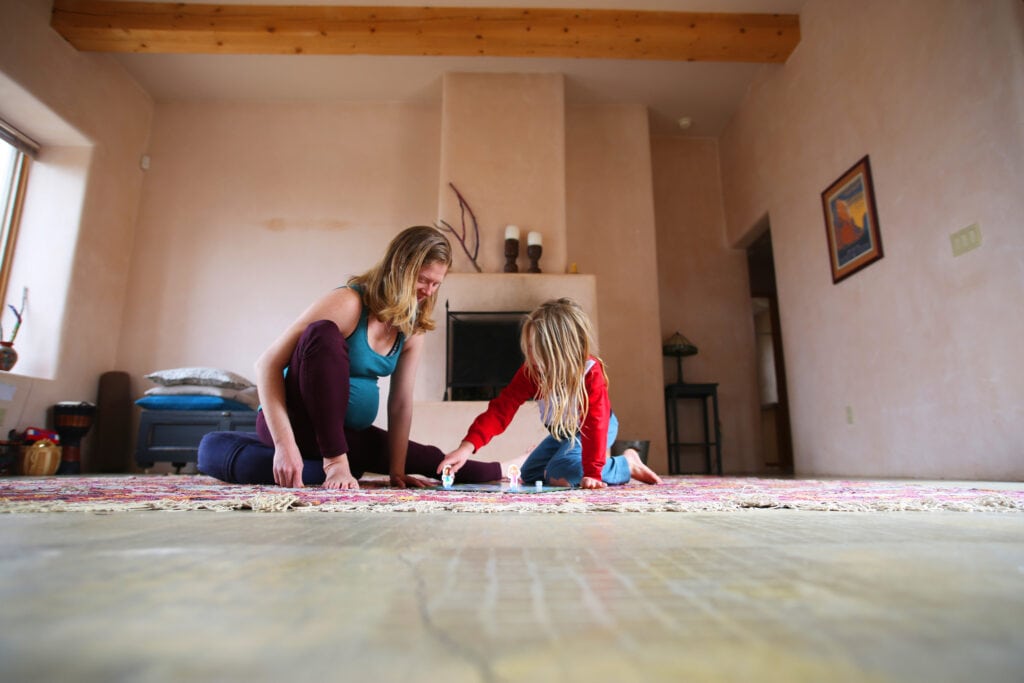
Why did you pick these particular spaces to share?
Other than the kitchen, these are two of the spaces we use the most and they are the ones that don’t still have moving boxes scattered around! My husband and I both work from home and we homeschool our son, so having space to play, work and rest well really matter.
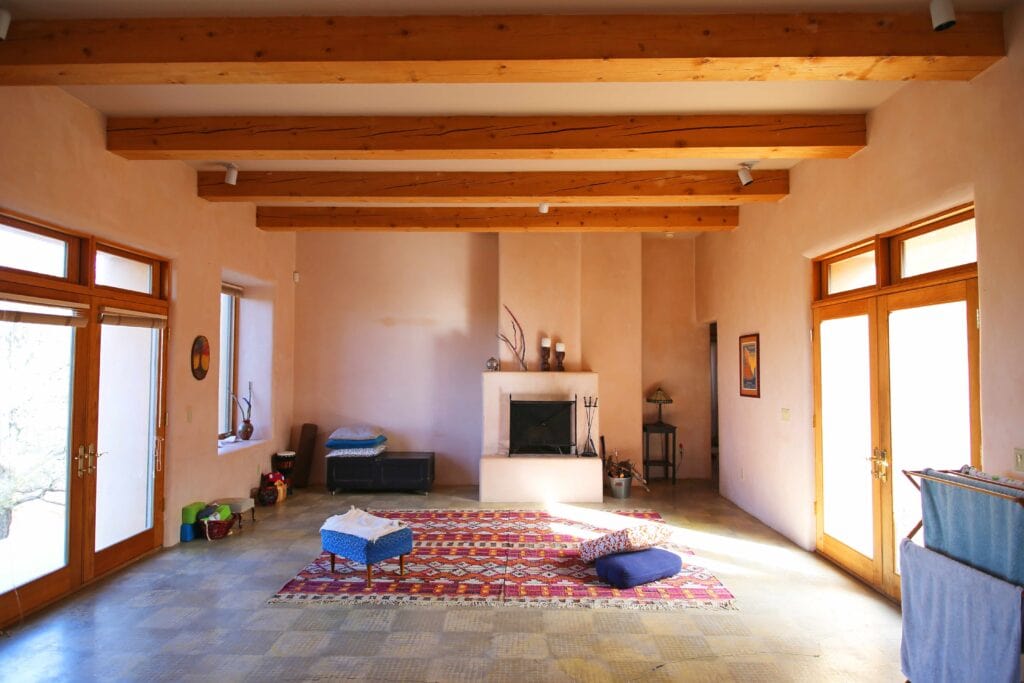
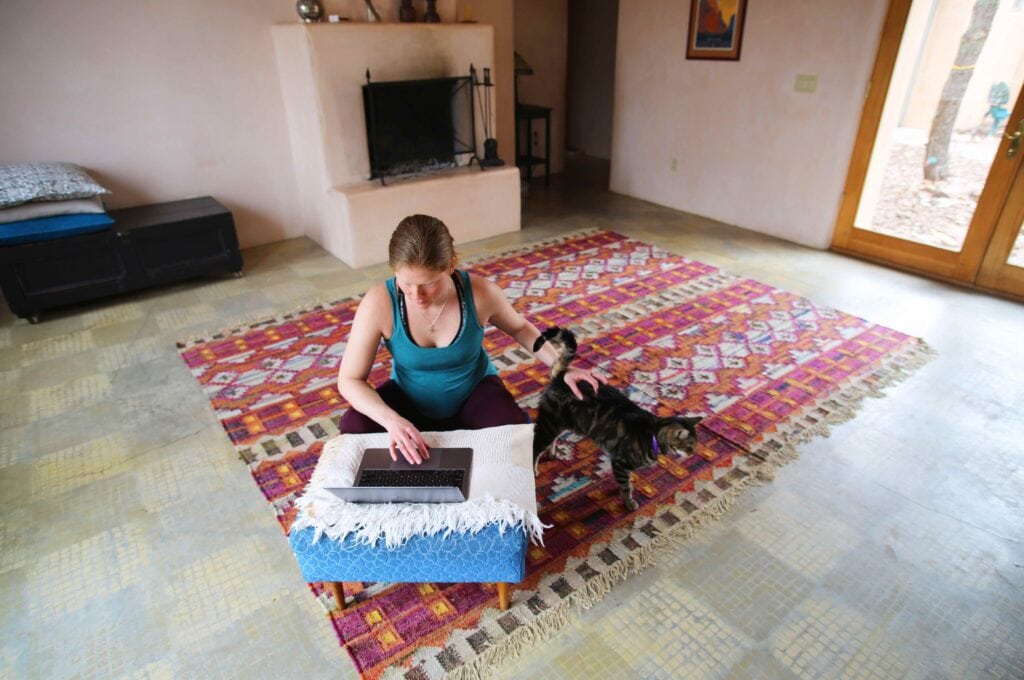
How do others feel about living with less furniture? Your partner? How about your family and guests?
My husband has been totally on board since the beginning when I first made the suggestion to ditch the couch. It’s a choice we made as a family to bring in more movement and we’ve continued to evolve our space together, adding or taking away as we feel best suits our lives and our values around hospitality.
The guest issue is a harder one. I love for people to feel comfortable! In our last home, we had a different space set-up that allowed us to have a traditional dining table that we used with guests and a low dining table that we used daily and I liked that balance. Overall, it’s worked so far, and yet I’d like to figure out how to become even more flexible with space so as to meet varying levels of movement ability and comfort.
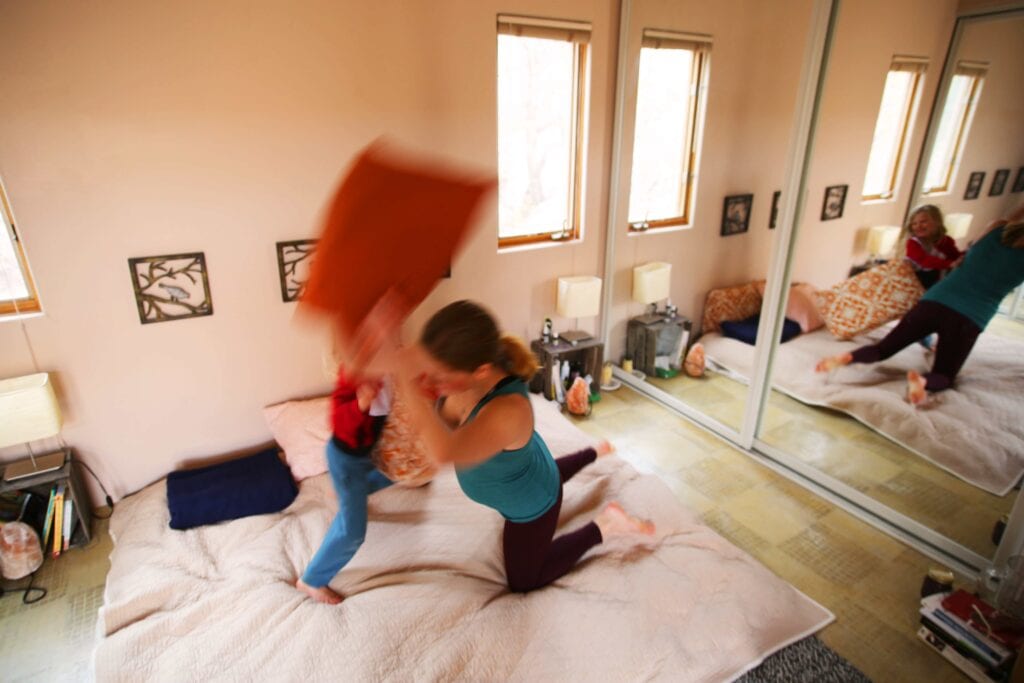
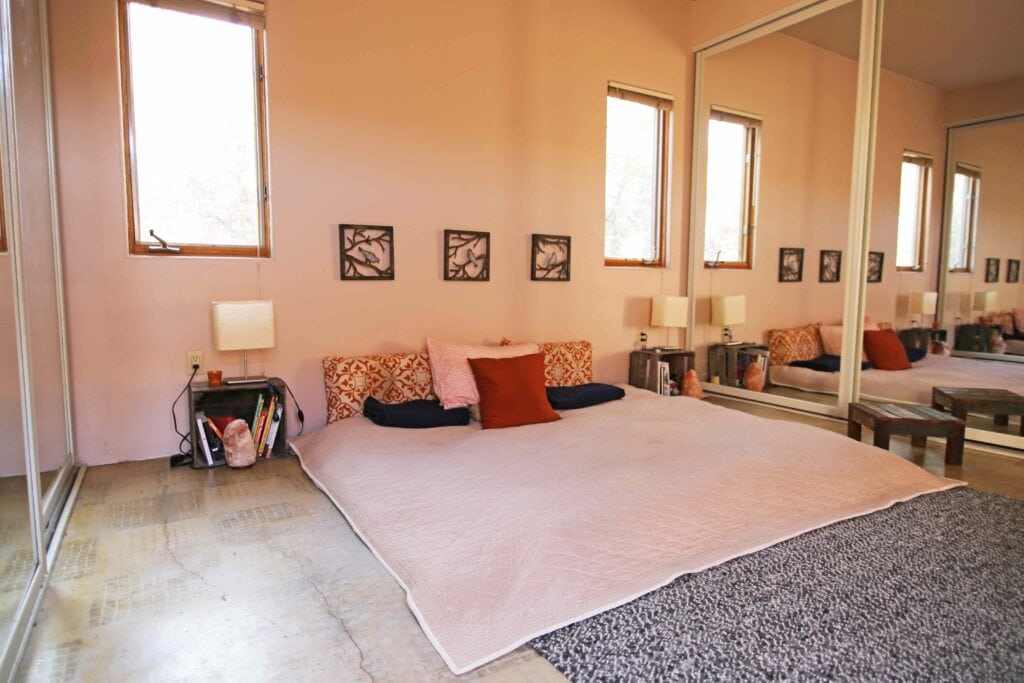
What do you love most about using less furniture?
Ah! So much! To start, I love the simplicity of the visual landscape and the simplicity of cleaning and I also love that space can be transformed relatively easily (roll up the bed!).
But what I really love is that I have to work harder in my body. Like most of us, I’m under-moved. Every bit of support I can take away requires that my daily tasks require a greater quantity and variety of movement.
Now that I’m pregnant, I’m really noticing the extra effort it takes to get in and out of a floor bed and up and down off the living room floor. I’m profoundly grateful to myself for having made these choices, knowing how nourishing it is to my body to move more and move differently, especially during this time.
The Freedom Of Going Furniture Free
I have been transitioning to a less furnished life, more movement-filled for at least four years now. Although getting more movement was my main motivation, I’ve found there are many other unexpected benefits.
The biggest ones for me are freedom and flexibility. Our space is easy to re-arrange and I do so every day. Our living room alternates as a movement studio, my office, and our dining room, simply by changing out simple furnishings like our coffee table, my movement props, and my yoga mats. There’s something I cherish about this versatility – it makes me feel very resilient and versatile – like I can deal with the unexpected changes of life itself more easily and with more grace.
As I interviewed my fellow movement teacher friends, I was struck by how we all mentioned how much we love the freedom of going furniture-free. There’s something amazing about changing your relationship with your living space. It’s empowering to both body and soul. For sure we all have very different spaces and very different lives, family situations, and personal style. But at the same time, we all seem to share this sense that a movement-friendly space is one that holds all kinds of opportunities to live in creative ways that nurture our bodies and support our values.
In closing, here are a few thoughts to help you on your own transition.
Furniture Free Isn’t Really Furniture Free
It’s good to remember that ‘furniture free’ is really not the best term for this type of lifestyle. It’s an alternative approach to furniture and space that allows more movement. It’s more minimal, the furnishings are typically smaller and closer to floor level, and they’re chosen to give us comfort, warmth, and options as we need them. The point is to make your life better, not to make it horrible, so pick stuff you love that lets you achieve both your movement goals and your life goals.
Transition At Your Own Pace
You don’t need to do this all at once. Starting can be as simple as getting a yoga bolster and sitting on it while others keep using the couch. Here are some ideas to help you transition.
For more lifestyle & wellness tips, sign up here to receive my weekly newsletter.


